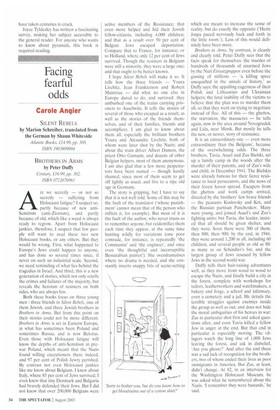Taking it with you
Jane Ridley
PYRAMIDS: THE REAL STORY BEHIND EGYPT'S MOST ANCIENT MONUMENTS by Joyce Tyldesley Viking, £18.99, pp. 262, ISBN 0670893226 The ancient Egyptians faced death in rather the same spirit as I contemplate packing to go on holiday. They couldn't bear to leave anything behind. I know I will curse myself as 1 lug a suitcase of unread books around Europe. But having read this excellent book, I can at least console myself with the reflection that the ancient Egyptians' inability to let go fuelled a gigantic leap forward in the history of mankind.
The ancient Egyptian elite went to the grave provided with all the clothing, games, food and furniture that they needed for eternity — someone even took a lavatory. In the end the problems of providing enough equipment proved so mindboggling that they took to using sign language and magic instead, To stop their bodies from decomposing, they mummified them, extracting the brain through the nose, eviscerating the soft internal organs, and drying the cadaver with natron salt before wrapping it in bandages. The tombs of the Egyptian elite needed to be big to accommodate all this clobber for the afterlife. They were also status symbols for the living. Kings especially needed to lavish money on extravagant tombs. Early Egyptian kings were buried in deep, square pits with their domestics (who were probably either sacrificed or persuaded to commit suicide) buried in small chambers beside them. When you add steps down to the king's burial chamber and cover it over with a roof built of stone, you get the first pyramid.
Building bigger and bigger pyramid tombs might seem a somewhat negative activity, literally a dead-end. In fact, pyramid-building was the major economic force that drove the Egyptian economy. To design the pyramid structure, Egypt's highpriest architects needed to understand the rules of mathematical proportion. The pyramids were built of great blocks of stone, and quarrying the stone and moving it by water to the site were feats of engineering that required sophisticated political organisation, prompting the development of the Egyptian state.
Joyce Tyldesley is particularly interesting about the Great Pyramid. Fanciful theories about divine guidance were exploded by the energetic Victorian archaeologist Flinders Petrie, who single-handedly surveyed the Great Pyramid to prove that it was built using mathematical proportion. Pyramid theorists still weave their theories, but for Egyptologists the puzzle is how this massive structure — Napoleon calculated that it contains enough stone to build a wall around France — could ever have been built. Tyldesley convincingly refutes the idea that it was built by vast gangs of slaves — in fact the pyramid-builders were well-organised gangs of labourers who lived in the pyramid town nearby. The paradox of pyramids is that the bigger and more conspicuous they were, the more likely they were to guarantee the afterlife; but a big pyramid was always an invitation to tomb robbers, who threatened the safety of the buried king. For this reason, the pyramid-builders went to inordinate lengths to baffle the robbers and protect the royal mummy, constructing puzzling complexes of tunnels which archaeologists have taken centuries to crack.
Joyce Tyldesley has written a fascinating survey, making her subject accessible to the general reader. For anyone who wants to know about pyramids, this book is required reading.



























































 Previous page
Previous page